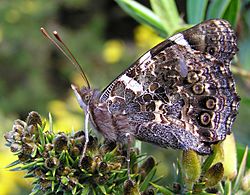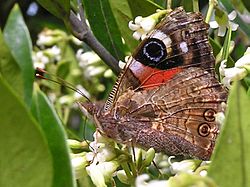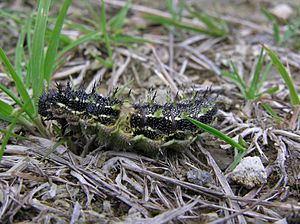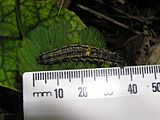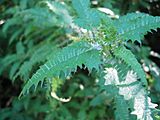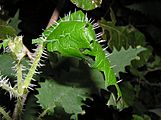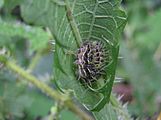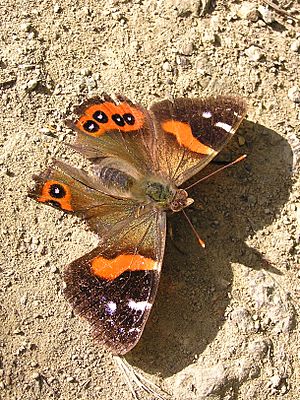New Zealand red admiral facts for kids
Quick facts for kids New Zealand red admiral |
|
|---|---|
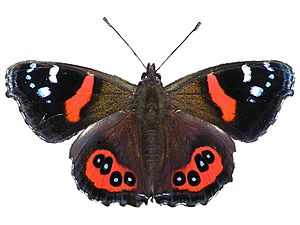 |
|
| Scientific classification | |
| Subspecies | |
|
|
| Synonyms | |
|
The New Zealand red admiral (Vanessa gonerilla) is a beautiful butterfly that lives only in New Zealand. Its Māori name is kahukura, which means "red cloak." This butterfly belongs to the family Nymphalidae, often called brush-footed butterflies. There are two types, or subspecies, of the red admiral: V. g. gonerilla, found on New Zealand's main islands, and V. g. ida, which lives on the Chatham Islands.
Contents
Description of the Red Admiral
The red admiral is a medium-sized butterfly. Its wingspan, the distance from one wingtip to the other, is about 50–60 mm. The top part of its front wings is mostly black. It has a bright red stripe running from the front edge. Near the tips of the front wings, you can see white spots with light blue edges.
The back wings are a dark reddish-brown. They have a red patch with four black circles, each with a pale blue center. The underside of the back wings looks like a mix of white, brown, and black shapes. This helps the butterfly hide when it rests. When the front wings are shown, their underside has a bright blue eyespot with white and red curved lines around it.
Where Red Admirals Live and What Threatens Them
Red admirals are quite common across New Zealand. They live in places where their special food plants grow. Some people have noticed that their numbers might have been going down since the early 1900s. For example, they are said to have disappeared from Auckland.
This decline is linked to the use of sprays and fewer native nettle plants. Nettle plants are also affected by dry weather. Groups like NZ Forest & Bird and some local councils are now growing nettle species. This helps provide food for the butterflies.
Another reason for the red admiral's decline is the presence of foreign parasitic wasps. The Australian white-spotted ichneumon wasp (Echthromorpha intricatoria) arrived on its own. Another wasp, Pteromalus puparum, was brought in by scientists in 1932–33. It was meant to control the cabbage white butterfly (Pieris rapae), which is a big farm pest in New Zealand. Studies have shown that these wasps can parasitize, or live on, a good number of red admiral pupae.
Life Cycle of the Red Admiral
The main food plant for red admiral caterpillars is the native stinging nettle, called ongaonga (Urtica ferox). However, the caterpillars can also eat other types of Urtica nettles. Throughout their lives, they use the nettle leaves for protection during the day. They do this by rolling the edge of a leaf around themselves. As they grow bigger, they might fold a whole leaf over to make a 'tent'.
The eggs are green, barrel-shaped, and have ridges. They are usually laid one by one on a leaf. The larva, or caterpillar, only eats enough of the eggshell to get out. This is different from the related yellow admiral larva, which eats the whole shell.
Caterpillars go through five growth stages, called instars. For about 10 days, they are brown with small white spots and fine hairs. After their first moult, at about 2.5 mm, they get a pale stripe along their body. Their hairs start to grow spikes. After another moult, at about 5 mm, the pale lines become clearer. At about 10 mm, they moult again, and the hairs get more spikes. The last moult happens when they are about 22 mm long. From there, caterpillars grow to about 36 mm before they change into a pupa. The pupa is usually about 20 mm long.
It can be tricky to tell red admiral and yellow admiral caterpillars apart. Yellow admiral caterpillars have a wider light-colored area on their 4th and 6th body segments. The red admiral pupa tends to be thinner and longer than the yellow admiral pupa.
Adult red admirals are seen most often during summer. They can live through the winter as adults. This means you might spot them on warm winter days. They live a long time, up to six months in summer. Those that survive winter might live for nine months.
Adult butterflies drink nectar from various plants, both native and introduced. Sometimes, they also feed on tree sap. They are strong fliers. When they are feeding or laying eggs, their flights are short and jerky. But when they fly over water or mountains, their flights are straight and fast. This is typical of butterflies that migrate, but no migration has been reported for them within New Zealand.
See also
 In Spanish: Kahukura para niños
In Spanish: Kahukura para niños


